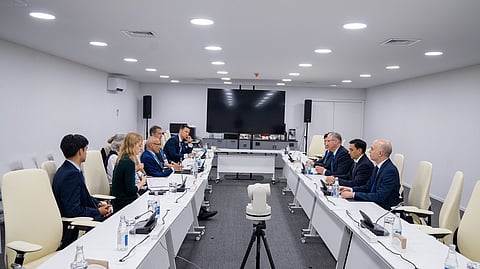

The 29th Conference of Parties (COP29) to the United Nations Framework Convention on Climate Change (UNFCCC) in Baku, Azerbaijan, began November 11, 2024. Here’s a look at what happened on the opening day of the global climate event. Also read the diary for November 12, November 13, November 14, November 15, November 16, November 18, November 19, November 20 and November 21.
After hours of delay, Parties adopted the agenda for COP29 after disagreement over some items listed in the provisional agenda. The COP presidential consultations centred on climate change-related, trade-restrictive unilateral measures, with the outcome expected to be declared at the closing ceremony. This item, however, did not make it into the agenda after China made a request on behalf of the BASIC (Brazil, South Africa, India, and China) bloc of countries for it to be included on the agenda on November 6, 2024. The trade-restrictive unilateral measures are a reference to carbon border taxes such as the European Union’s Carbon Border Adjustment Mechanism.
Also on the agenda is the United Arab Emirates (UAE) dialogue on implementing the global stocktake (GST) outcomes, which will be discussed under Matters related to Finance with a footnote that its placement in the agenda “does not prejudge its scope”.
On Day 1, the COP29 President announced that Parties have reached a consensus on standards for carbon credits under Article 6.4 of the Paris Agreement, also known as the Paris Agreement Crediting Mechanism. Carbon credits represent 1 tonne of carbon dioxide or the equivalent GHGs (CO2e) avoided and are issued against activities that either avoid greenhouse gas emissions (such as by using an efficient cook stove or lighting system) or removing GHGs from the atmosphere (for instance, by planting trees).
This comes a few hours after the Presidency proposed a draft decision on Article 6.4 endorsing the adoption for methodologies (calculating emission reductions) and carbon removal (to remove carbon dioxide from the atmosphere), which was adopted by the Article 6.4 Supervisory Body — a technical body tasked with overseeing Article 6.4 — last month. The Body requested the Conference of the Parties serving as the meeting of the Parties to the Paris Agreement (CMA), a governing body, to endorse these standards and provide any additional guidance. Last year at COP28 in Dubai, the parties did not reach a consensus as they felt the guidelines were inadequate.
This signals a key development in the operationalisation of Article 6.4-based carbon market.
In a press conference, the US Senior Advisor to the President for International Climate Policy John Podesta said the US election outcome was disappointing. He added that it is clear the next administration may take a U-turn and reverse many of these developments. But support for clean energy has become bipartisan in US, he noted. Podesta also expressed his support for expanding donor base to include more countries “to make sure developing countries have financing they need for mitigation and adaptation”. He also noted that it was important to improve access to finance for vulnerable countries.
Azerbaijan COP29 President Mukhtar Babayev indicated that future COP Presidency rotations would go to “Western Europe and other States” for COP31 and “African States” for COP32.
A quick analysis of the COP29 provisional list of registered participants by CSE shows that the largest Party delegations are registered by Azerbaijan (995), Brazil (984), and Russia (900). There are 66,000 delegates registered for onsite participation, 33,000 Party and Party overflow, 13,000 Observers, 3,500 Media and 14,500 Others.
New NDCs have been announced by two members of the current ‘COP Troika'of UAE, Azerbaijan, and Brazil. Brazil announced a target to cut emissions by 59-67 per cent from 2005 levels by 2035, on the way to net zero by 2050. The UAE said it will be cutting greenhouse gas emissions by 47 per cent from 2019 levels by 2035, up from the previous 40 per cent target for 2030.